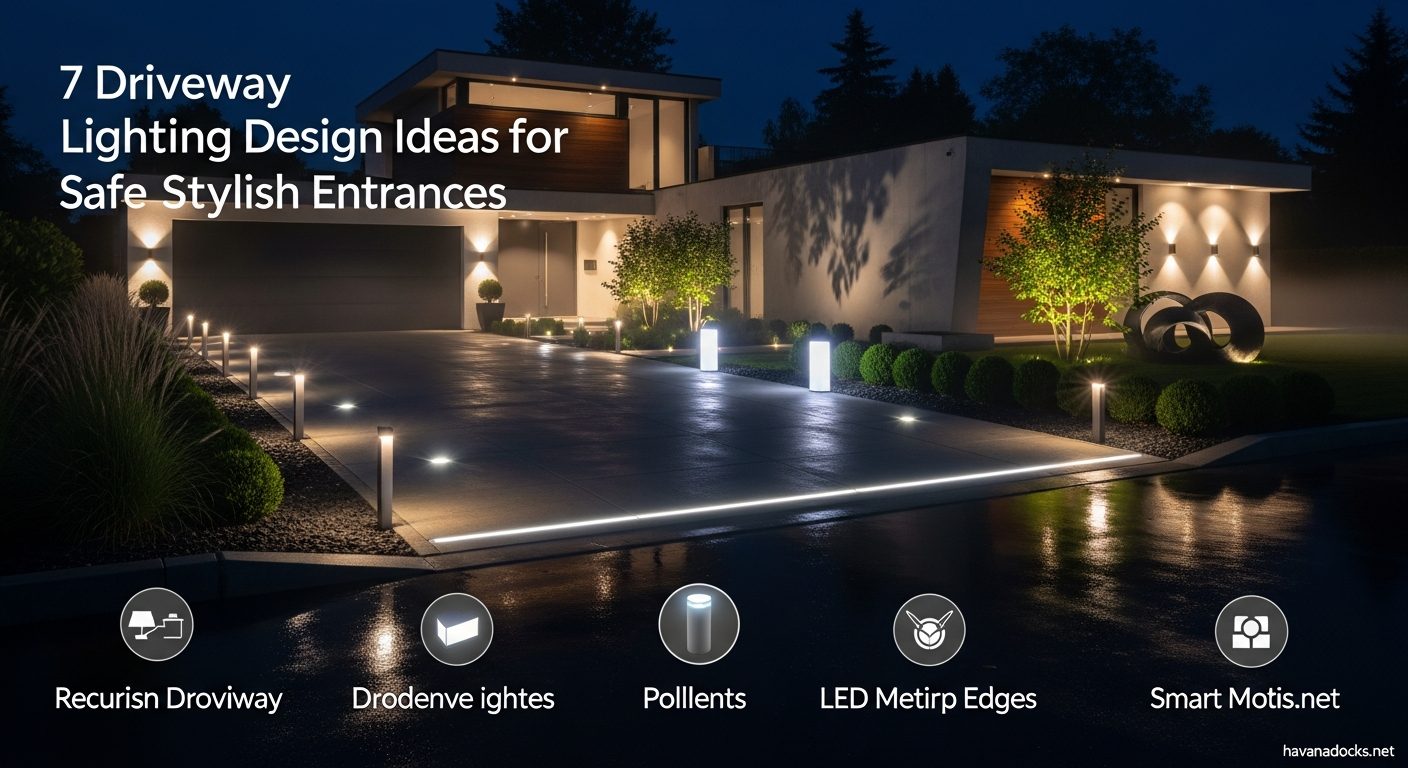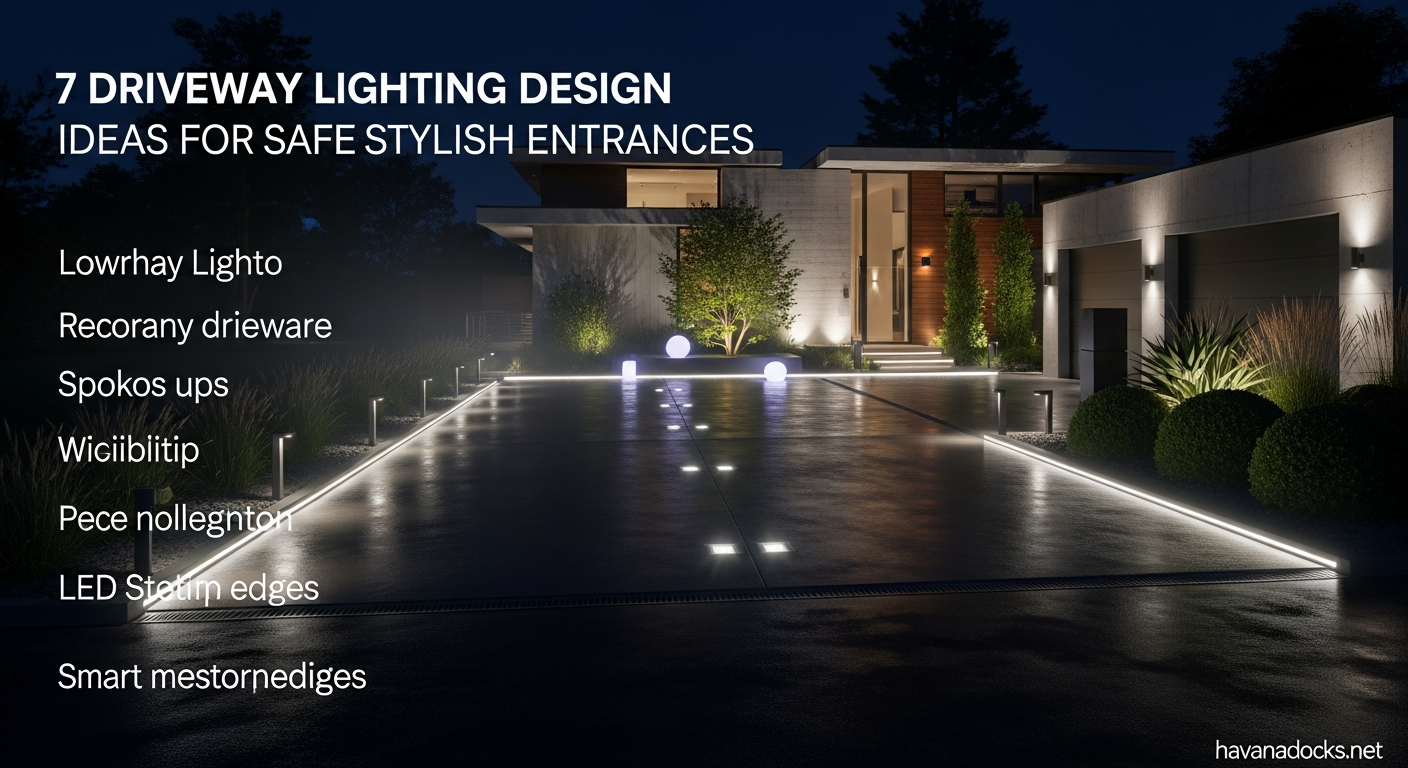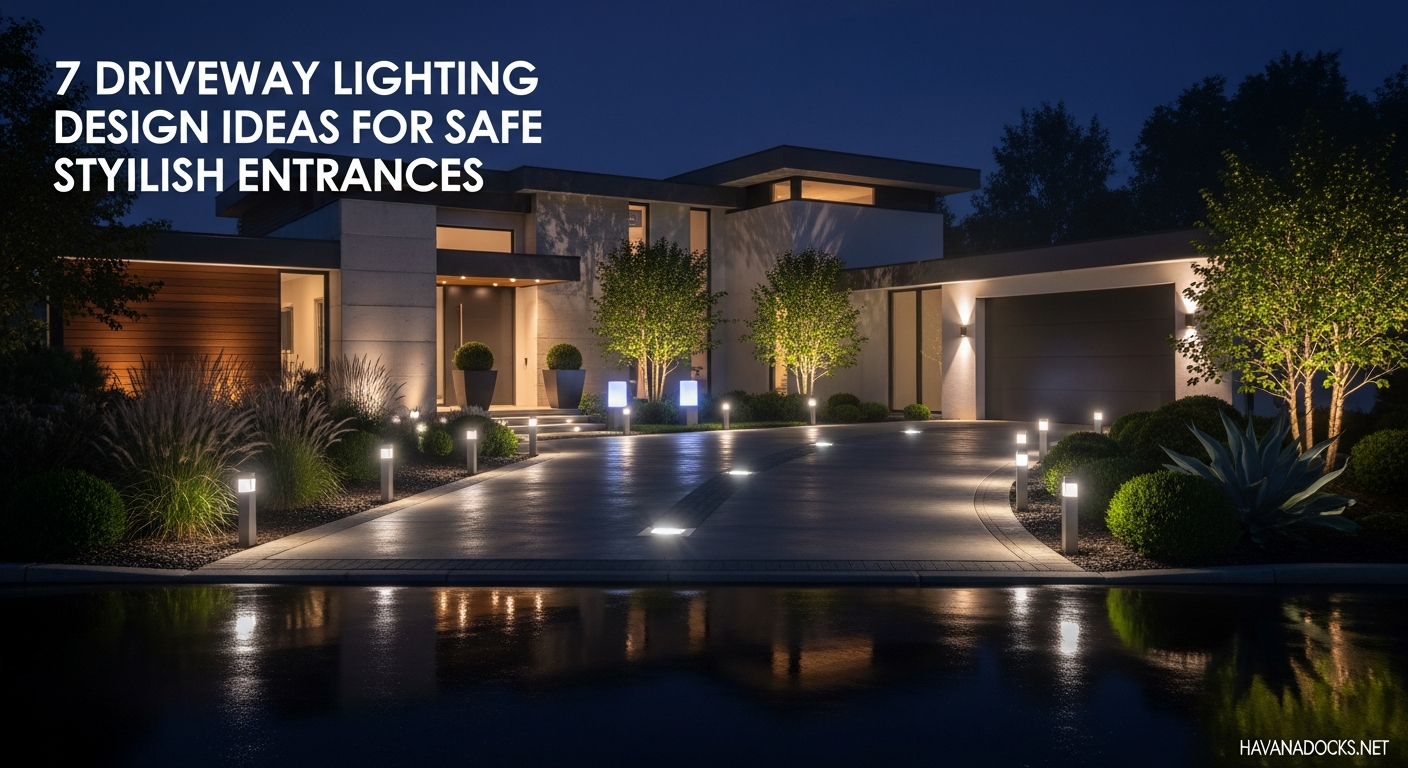7 Driveway Lighting Design Ideas for Safe Stylish Entrances
7 Driveway Lighting – Choosing the right driveway lighting design involves considering several factors, from the architectural style of your house to the practical needs of your family. It’s a balance between aesthetics, security, and energy efficiency. Let’s explore seven effective and stylish driveway lighting ideas.

1. Path Lighting for a Guiding Glow
Path lights are a classic and versatile option for illuminating driveways. They gently guide visitors along the driveway’s edge, creating a warm and inviting ambiance.
- Types of Path Lights: Bollard lights, mushroom lights, and low-voltage landscape lights are all popular choices. Bollard lights offer a more substantial presence, while mushroom lights provide a subtle, diffused glow. Low-voltage lights are energy-efficient and easy to install.
- Placement Considerations: Strategically place path lights along the sides of the driveway, ensuring adequate spacing for consistent illumination. Consider the width of your driveway and the desired level of brightness when determining the number of lights needed. Overcrowding can look cluttered, while too few lights can leave dark spots. Experiment with staggered placements for a more natural, less rigid look.
2. Post Lights for a Grand Entrance
Post lights, mounted on pillars or columns, add a touch of elegance and formality to your driveway entrance. They provide enhanced visibility and define the boundaries of your property.
- Choosing the Right Style: Select post lights that complement the architectural style of your home. Options range from traditional lanterns to modern, minimalist designs. Consider the material and finish of the lights to ensure they withstand the elements. Common materials include cast iron, aluminum, and stainless steel.
- Height and Spacing: The height of the post lights should be proportionate to the size of your entryway and the height of your home. Adequate spacing between posts is crucial for even illumination. Generally, posts should be spaced no more than 8-10 feet apart.
- Incorporating Smart Technology: Integrate smart technology into your post lights for added convenience and control. Smart lights can be programmed to turn on automatically at dusk and off at dawn. You can also adjust the brightness and color temperature remotely using a smartphone app.
3. Recessed Lights for a Sleek, Subtle Look
Recessed driveway lights offer a unobtrusive and modern approach to driveway lighting design. Installed flush with the driveway surface, they provide subtle illumination without taking up visual space.
- Benefits of Recessed Lighting: Recessed lights are ideal for creating a clean, minimalist aesthetic. They are also highly durable and can withstand the weight of vehicles.
- Installation Considerations: Professional installation is recommended for recessed driveway lights to ensure proper wiring and drainage. It’s important to choose lights that are specifically designed for driveway use and are rated for outdoor conditions.
- Light Distribution: Recessed lighting generally provides uplighting, which can highlight textures and materials. Consider the color of your driveway surface, as darker surfaces will absorb more light.
4. Spotlight for Targeted Illumination
Spotlights are an excellent way to highlight specific features of your property, such as landscaping, architectural details, or security cameras.
- Highlighting Architectural Features: Strategically placed spotlights can draw attention to interesting architectural elements of your home. A well-placed spotlight can showcase the texture of a stone facade or the shape of a decorative window.
- Enhanced Security: Use spotlights to illuminate vulnerable areas of your property, such as entryways, garages, and dark corners. Motion-activated spotlights can provide an extra layer of security by deterring potential intruders.
- Landscaping Enhancement: Uplighting trees, shrubs, and other landscaping features can add drama and depth to your outdoor space. Experiment with different colors and beam angles to create unique visual effects.
5. String Lights for a Festive Ambiance
String lights, or fairy lights, can add a touch of whimsy and charm to your driveway lighting design. They are perfect for creating a welcoming and festive atmosphere. If you desire a more relaxed and comforting appearance, this driveway lighting design might be a great choice.
- Choosing Durable String Lights: Opt for outdoor-rated string lights that are weatherproof and designed to withstand the elements. Look for lights with durable bulbs and sturdy wiring.
- Creative Placement Ideas: Drape string lights along fences, trees, or pergolas to create a magical effect. You can also string them across the driveway entrance to welcome guests.
- Combining with Other Lighting: String lights can be combined with other types of driveway lighting to create a layered and dynamic lighting scheme. Consider using path lights or spotlights to complement the string lights.
6. Solar Lights for Energy Efficiency
Solar-powered driveway lights are an environmentally friendly and cost-effective way to illuminate your property. They harness the power of the sun to provide wireless and maintenance-free lighting.
- Benefits of Solar Lighting: Solar lights require no wiring, making them easy to install. They are also energy-efficient and can save you money on your electricity bill.
- Choosing Quality Solar Lights: Look for solar lights with high-capacity batteries and efficient solar panels. The amount of sunlight your driveway receives will affect the performance of the lights.
- Placement for Optimal Sunlight: Position your solar lights in areas where they will receive maximum sunlight throughout the day. Avoid placing them in shaded areas.
7. Smart Lighting: Integrating Technology for Convenience and Security
Smart driveway lighting design provides unparalleled control and convenience. These systems allow you to automate your lighting and customize your landscape.
- Remote Control and Scheduling: Smart lights can be controlled remotely using a smartphone app. You can set schedules to turn the lights on and off automatically, adjust the brightness, and even change the color temperature.
- Motion Sensor Integration: Integrate motion sensors with your smart lighting system for enhanced security. When motion is detected, the lights can automatically turn on, deterring potential intruders.
- Integration with Home Automation Systems: Smart driveway lighting can be integrated with other home automation systems, such as security systems and smart thermostats. This allows you to create a seamless and integrated smart home experience.

Security Benefits of Thoughtful Driveway Lighting Design
Beyond aesthetics, your driveway lighting design plays a pivotal role in enhancing the security of your home. Well-placed lights deter potential intruders and improve visibility for residents and visitors.
Increased Visibility
A properly illuminated driveway enhances visibility, making it easier to navigate the area at night. This reduces the risk of accidents and injuries.
Deterrent to Crime
Criminals are less likely to target a property that is well-lit. Bright lights can deter potential intruders and make your home a less attractive target.
Enhanced Surveillance
Driveway lighting, when used in conjunction with security cameras, can improve the quality of surveillance footage. This can be invaluable in the event of a break-in or other security incident.
Planning Your Driveway Lighting Design Project
Before diving into your driveway lighting design project, thoughtful planning is essential to ensure successful installations, longevity, and the impact you hope to achieve. Lighting plays a significant role in both safety and aesthetics, so approaching the project with a strategic mindset will help you create a design that is functional, visually appealing, and built to withstand time and weather conditions.
Start by assessing your driveway’s layout, width, and materials. Consider how vehicles move in and out, where shadows naturally fall, and which areas require enhanced visibility. These observations help determine the type and placement of lighting fixtures. For example, long or curved driveways benefit from low-profile path lights that guide drivers safely, while straight driveways may require more subtle illumination to avoid unnecessary glare.
Once you understand the functional needs, you can focus on the visual impact. Decide whether you want your lighting to create a dramatic, luxurious ambience or a softer, understated glow. Uplights can accent architectural features, trees, or stone borders, while downlights can highlight plants and landscape textures in a more natural, diffused manner. Pairing different lighting types can add depth and dimension to your driveway design.
Energy efficiency is another crucial factor. LED fixtures are the most common choice due to their long lifespan, low energy consumption, and wide range of brightness options. Solar-powered lights are ideal for eco-friendly homeowners or areas where wiring may be difficult to install, though their performance depends heavily on sunlight exposure. Smart lighting systems offer even more control, allowing you to adjust brightness, schedule light patterns, or activate motion sensors for added security.
Durability should also be prioritized. Choose fixtures made from weather-resistant materials such as stainless steel, aluminum, or treated metal to ensure they withstand rain, heat, and long-term outdoor conditions. Proper installation methods—such as burying wires deeply, using waterproof connectors, and securing fixtures firmly—help extend the lifespan of your lighting system.
Lastly, think about maintenance. Opt for lights with easy-access bulbs, replaceable parts, or self-cleaning designs to minimize long-term upkeep. Regularly trimming surrounding plants and ensuring fixtures remain clear of debris will keep your lighting system performing at its best.
By approaching your driveway lighting project with careful planning, you’ll not only enhance safety and visibility but also create a captivating nighttime landscape that elevates your home’s curb appeal and overall outdoor experience.
Assessing Your Needs
Consider your property’s specific needs and characteristics. Factors to consider include the size and shape of your driveway, the architectural style of your home, and your personal preferences.
Setting a Budget
Determine your budget for the project and prioritize your lighting needs accordingly. Remember to factor in the cost of materials, installation, and electricity.
Creating a Lighting Plan
Develop a detailed lighting plan that outlines the placement, type, and intensity of each light fixture. Consider the overall aesthetic you want to achieve and how the lighting will enhance the curb appeal of your home.
Understanding Local Regulations
Be sure to research local codes and ordinances regarding outdoor lighting. Some municipalities have regulations regarding light pollution and glare.
Choosing the Right Lighting Fixtures and Bulbs for Your Driveway
Selecting fixtures and bulbs for your driveway lighting needs involves prioritizing durability, brightness, and energy efficiency. Because outdoor lighting is exposed to the elements year-round, choosing the right components ensures long-lasting performance, consistent illumination, and a visually appealing final result. Thoughtful selection also helps reduce maintenance, enhance safety, and create the atmosphere you envision for your home’s exterior.
Durability and Weather Resistance
Choose fixtures that are designed for outdoor use and are resistant to corrosion, rust, and other weather-related damage. Materials such as stainless steel, aluminum, bronze, and powder-coated metals are commonly used in high-quality driveway lighting systems due to their ability to withstand rain, humidity, heat, and sunlight. If your home is located in a coastal area, where salt in the air can accelerate corrosion, look for marine-grade fixtures that offer enhanced protection. Waterproof or water-resistant ratings are also essential—fixtures with an IP65 or higher rating are ideal for ground-level lighting, ensuring they remain protected from dust, moisture, and water jets.
Beyond material durability, it’s also important to consider the quality of seals and gaskets used in the fixture. These elements prevent water intrusion, which can cause internal damage or shorten the lifespan of the bulb. UV-resistant coatings are another bonus, helping maintain the fixture’s appearance by preventing discoloration or fading from prolonged sun exposure.
Brightness Levels and Color Temperature
Consider the brightness levels and color temperature of the bulbs you choose. Warmer color temperatures (2700K–3000K) create a cozy and inviting atmosphere, ideal for homes that want a soft, welcoming glow along the driveway. This lighting style is often preferred for traditional, rustic, or classic home designs. On the other hand, cooler color temperatures (4000K–5000K) provide brighter, more focused illumination—making them suitable for modern or contemporary homes where crisp, clean lighting is part of the aesthetic. Cooler tones are also beneficial for visibility and security since they illuminate more clearly and can help distinguish objects in darker areas.
The brightness, measured in lumens, should be selected based on the size and purpose of your driveway. For subtle pathway lighting, 100–300 lumens may be sufficient. For larger driveways or areas requiring enhanced visibility, you may need fixtures ranging from 400–1200 lumens. Balancing brightness helps prevent glare, especially for drivers entering or exiting the property.
Energy Efficiency
LED bulbs remain the best choice for driveway lighting due to their long lifespan, low energy consumption, and superior performance. They generate less heat, resist shock and vibration, and maintain consistent color and brightness for years. Many LED fixtures are also compatible with timers, motion sensors, and smart home systems, offering greater control and convenience.
By selecting durable fixtures, appropriate brightness levels, and energy-efficient bulbs, you can create a driveway lighting design that is not only beautiful but also functional, reliable, and cost-effective in the long run.
LED vs. Halogen
LED bulbs are significantly more energy-efficient and long-lasting than halogen bulbs. They also produce less heat and are available in a wide range of colors and brightness levels.
Smart Bulbs Considerations
Smart bulbs offer a wide range of features, including remote control, scheduling, and dimming capabilities. Consider the compatibility of smart bulbs with your existing home automation system.

Maintaining Your Driveway Lighting System
Proper maintenance is crucial for ensuring the longevity and performance of your driveway lighting design. Even the highest-quality fixtures can lose effectiveness over time if not cared for, so a consistent maintenance routine helps preserve both functionality and aesthetic appeal.
Regular Cleaning
Clean your light fixtures regularly to remove dirt, dust, and debris. Outdoor lighting is exposed to weather, insects, and plant materials, all of which can accumulate on the lens and reduce brightness. Gently wiping the surface with a soft cloth and mild cleaner can restore clarity and ensure maximum illumination. For pathway lights or ground-level fixtures, it’s important to check for mud buildup or encroaching grass that may obscure the light. Regular cleaning also helps prevent long-term corrosion, especially in humid or coastal environments where metal components may be more susceptible to rust.
Bulb Replacement
Replace burnt-out bulbs promptly to ensure consistent illumination. Incomplete lighting not only reduces the visual appeal of your driveway but can also create unsafe dark spots. When replacing bulbs, consider switching to LED options if you haven’t already. LEDs offer longer lifespans, greater energy efficiency, and improved brightness control, making them ideal for outdoor applications. Many modern LED fixtures are also designed to emit a consistent color temperature, maintaining a cohesive appearance across your entire lighting layout.
Fixture Inspection
Periodically inspect each fixture for signs of wear, such as loose screws, cracked lenses, or frayed wiring. Addressing small issues early prevents more costly repairs later. Ensure that fixtures remain securely anchored in the ground and are positioned correctly, as shifting soil, lawn maintenance, or weather can cause them to tilt or become misaligned.
Landscape Management
Finally, maintain the landscaping around your lighting. Overgrown shrubs, tall grass, or fallen leaves can obscure the light or trap moisture around the fixtures. Keeping the surrounding area tidy ensures your lighting continues to function effectively and enhances the overall appearance of your driveway.
With proper maintenance, your driveway lighting will remain bright, reliable, and visually striking for years to come.
Checking Wiring and Connections
Periodically inspect the wiring and connections of your driveway lighting system to ensure they are secure and free from damage.
Conclusion
Thoughtful driveway lighting design is an investment that enhances the safety, security, and aesthetic appeal of your home. By carefully considering your needs, budget, and preferences, you can create a welcoming and stylish entrance that reflects your personal style. From classic path lights to smart lighting systems, there are numerous options available to illuminate your driveway and elevate your home’s curb appeal. Proper planning, fixture selection, and regular maintenance will ensure that your driveway lighting system remains a valuable asset for years to come.





